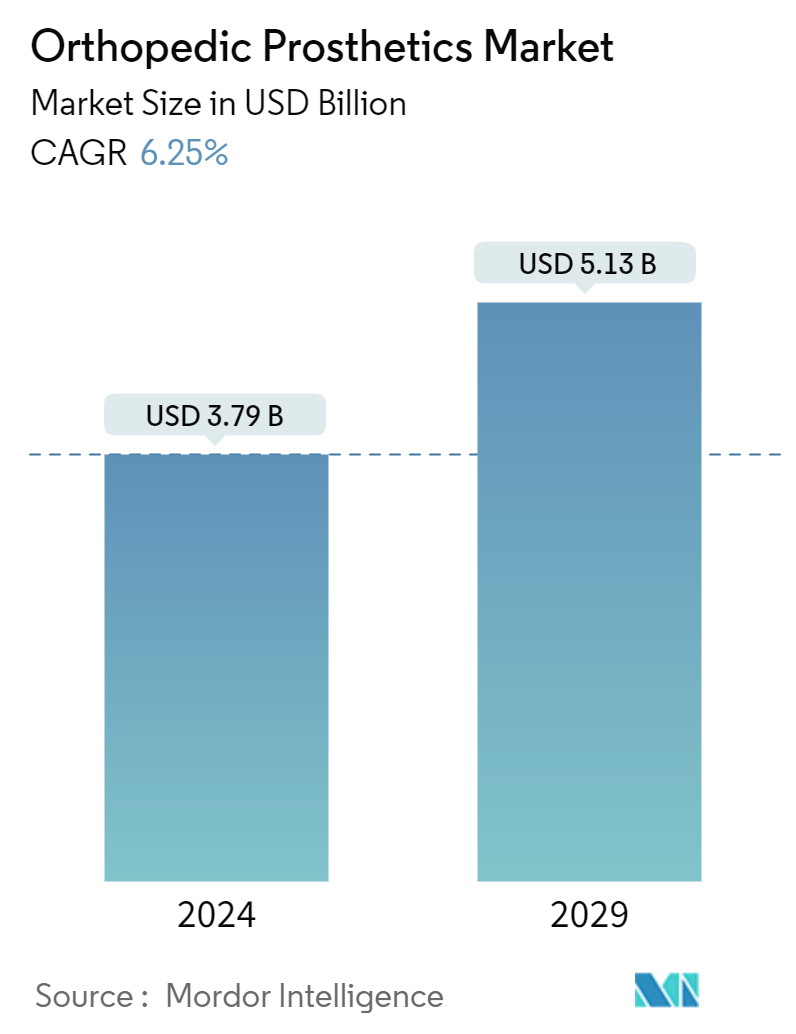Market Size of Orthopedic Prosthetics Industry

| Study Period | 2019 - 2029 |
| Market Size (2024) | USD 3.79 Billion |
| Market Size (2029) | USD 5.13 Billion |
| CAGR (2024 - 2029) | 6.25 % |
| Fastest Growing Market | Asia-Pacific |
| Largest Market | North America |
Major Players
*Disclaimer: Major Players sorted in no particular order |
Orthopedic Prosthetics Market Analysis
The Orthopedic Prosthetics Market size is estimated at USD 3.79 billion in 2024, and is expected to reach USD 5.13 billion by 2029, growing at a CAGR of 6.25% during the forecast period (2024-2029).
From the initial period of the COVID-19 pandemic, orthopedic surgeries have been delayed, leading to a decline in the usage of prosthetics. As per data from the University of Birmingham, published in the British Journal of Surgery in May 2020, about 6.3 million orthopedic surgeries were postponed or canceled worldwide due to the pandemic. However, with the resumption of activities, a sudden upsurge in the consumption of prosthetics can be expected. Regulatory bodies such as the Centers for Disease Control and Prevention (CDC) provided various guidelines on managing surgical procedures during the pandemic. Therefore, the pandemic has had a significant impact on the market globally.
Certain factors driving the market's growth include increasing trauma cases and accidental injuries, technological advancements, and the rising burden of osteosarcoma. According to the statistics of the Arthritis Foundation, in 2021, more than 350 million people had arthritis globally. While the same data revealed that an estimated 30.8 million adults were found to be suffering from arthritis, and 14 million individuals in the United States were suffering from symptomatic knee osteoarthritis. By 2050, the number of adults in the United States with doctor-diagnosed osteoarthritis is projected to increase by 49% to 78.4 million, accounting for 25.9% of the total population. The number of adults reporting activity limitations due to arthritis will increase by 52%, to 34.6 million, by 2040. Therefore, owing to the high numbe of people suffering from orthopedic conditions, the market is expected to witnss strong growth in the coming years.
Product launches are key factors boosting the growth of the market. For instance, in November 2021, Össur, a global leader in innovative prosthetic and non-invasive orthopedic technologies, launched three new models of its iconic Cheetah sports prosthesis, which have been designed for amputee athletes participating in specific athletic applications, including sprinting, distance running, and long jumping. Such new launches in the market are contributing significantly to the market's growth.
However, the high cost of prosthetic devices is expected to hinder the market's growth in the future.
Orthopedic Prosthetics Industry Segmentation
Orthopedic prosthetics assist with artificial limbs, bones, and joints. Orthopedic prosthetics involve the use of artificial limbs (prostheses) to enhance the function and lifestyle of persons with limb loss caused by trauma, disease, or other medical conditions.
The orthopedic prosthetics market is segmented by product (upper extremity prosthetics, lower extremity prosthetics, sockets, and other products), technology (conventional, electric-powered, and hybrid orthopedic prosthetics), end user (hospitals, prosthetic centers, and other end users), and geography (North America, Europe, Asia-Pacific, Middle East & Africa, and South America). The report offers the value (in USD million) for the above-mentioned segments.
| By Product | |
| Upper Extremity Prosthetics | |
| Lower Extremity Prosthetics | |
| Sockets | |
| Other Products |
| By Technology | |
| Conventional | |
| Electric-powered | |
| Hybrid Orthopedic Prosthetics |
| By End User | |
| Hospitals | |
| Prosthetic Centers | |
| Other End Users |
| By Geography | ||||||||
| ||||||||
| ||||||||
| ||||||||
| ||||||||
|
Orthopedic Prosthetics Market Size Summary
The orthopedic prosthetics market is poised for significant growth, driven by factors such as increasing trauma cases, technological advancements, and the rising prevalence of orthopedic conditions like osteosarcoma and arthritis. The market experienced a temporary setback during the COVID-19 pandemic due to delayed surgeries, but the resumption of activities has led to a surge in prosthetic consumption. Regulatory bodies have played a crucial role in managing surgical procedures during the pandemic, ensuring that orthopedic and prosthetic practices remained accessible. The introduction of innovative products, such as Össur's Cheetah sports prosthesis and advancements in electric prostheses, has further fueled market expansion. These developments are expected to meet the growing demand for natural-looking and functionally advanced prosthetic devices.
In North America, the orthopedic prosthetics market benefits from a robust healthcare infrastructure, a strong distribution network, and the presence of key regional players. Companies are focusing on developing lightweight and durable prosthetic solutions tailored to patient needs. Strategic partnerships and acquisitions among major players, such as WillowWood Global LLC's collaboration with Blue Sea Capital LLC, are enhancing market growth by increasing funding and fostering innovation. The market's competitive landscape is characterized by the presence of significant players like Fillauer LLC, Mobius Bionics, and Blatchford Ltd, who are actively engaging in strategic alliances to strengthen their market positions. As a result, the orthopedic prosthetics market is expected to witness sustained growth in the coming years, supported by novel product introductions and strategic industry movements.
Orthopedic Prosthetics Market Size - Table of Contents
-
1. MARKET DYNAMICS
-
1.1 Market Overview
-
1.2 Market Drivers
-
1.2.1 Increasing Number of Trauma Cases and Accidental Injuries
-
1.2.2 Technological Advancements
-
1.2.3 Rising Prevalence of Osteosarcoma
-
-
1.3 Market Restraints
-
1.3.1 Lack of Proper Reimbursement Policies
-
1.3.2 High Cost of Prosthetic Devices
-
-
1.4 Porter's Five Forces Analysis
-
1.4.1 Threat of New Entrants
-
1.4.2 Bargaining Power of Buyers/Consumers
-
1.4.3 Bargaining Power of Suppliers
-
1.4.4 Threat of Substitute Products
-
1.4.5 Intensity of Competitive Rivalry
-
-
-
2. MARKET SEGMENTATION (Market Size by Value - USD million)
-
2.1 By Product
-
2.1.1 Upper Extremity Prosthetics
-
2.1.2 Lower Extremity Prosthetics
-
2.1.3 Sockets
-
2.1.4 Other Products
-
-
2.2 By Technology
-
2.2.1 Conventional
-
2.2.2 Electric-powered
-
2.2.3 Hybrid Orthopedic Prosthetics
-
-
2.3 By End User
-
2.3.1 Hospitals
-
2.3.2 Prosthetic Centers
-
2.3.3 Other End Users
-
-
2.4 By Geography
-
2.4.1 North America
-
2.4.1.1 United States
-
2.4.1.2 Canada
-
2.4.1.3 Mexico
-
-
2.4.2 Europe
-
2.4.2.1 Germany
-
2.4.2.2 United Kingdom
-
2.4.2.3 France
-
2.4.2.4 Italy
-
2.4.2.5 Spain
-
2.4.2.6 Rest of Europe
-
-
2.4.3 Asia-Pacific
-
2.4.3.1 China
-
2.4.3.2 Japan
-
2.4.3.3 India
-
2.4.3.4 Australia
-
2.4.3.5 South Korea
-
2.4.3.6 Rest of Asia-Pacific
-
-
2.4.4 Middle East & Africa
-
2.4.4.1 GCC
-
2.4.4.2 South Africa
-
2.4.4.3 Rest of Middle East & Africa
-
-
2.4.5 South America
-
2.4.5.1 Brazil
-
2.4.5.2 Argentina
-
2.4.5.3 Rest of South America
-
-
-
Orthopedic Prosthetics Market Size FAQs
How big is the Orthopedic Prosthetics Market?
The Orthopedic Prosthetics Market size is expected to reach USD 3.79 billion in 2024 and grow at a CAGR of 6.25% to reach USD 5.13 billion by 2029.
What is the current Orthopedic Prosthetics Market size?
In 2024, the Orthopedic Prosthetics Market size is expected to reach USD 3.79 billion.

